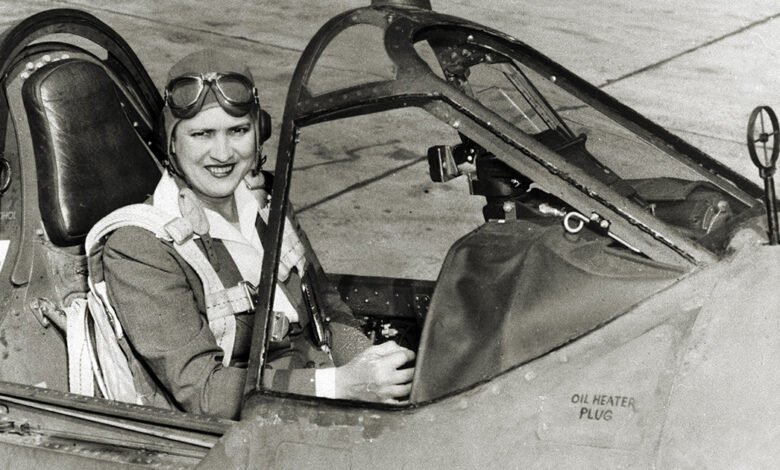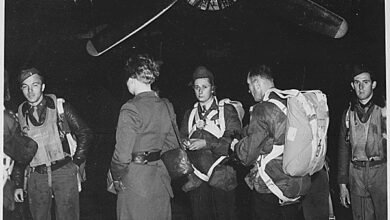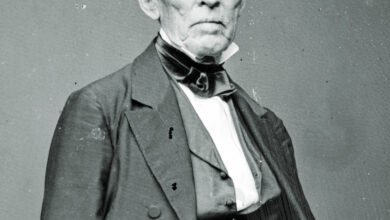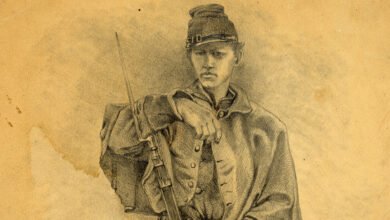
Jacqueline Cochran waited impatiently in her New York City apartment while a group of men in Canada debated her fate. It was June 1941, and the renowned pilot hoped to ferry an American bomber across the Atlantic and deliver it to the Royal Air Force. Cochran was already well known for daredevil record-breaking flights but she also ran a cosmetics business, activities that might seem incompatible. But while she believed that women were just as good at flying airplanes as men, Cochran also felt it was “a woman’s duty to be as presentable as her circumstances of time and purse permit.” Her own available time might just be a few minutes to comb her hair and daub on fresh lipstick at the end of an 11-hour flight, but Cochran always looked as if she had just stepped out of a beauty salon.
Cochran had done everything possible to prepare for the transatlantic flight. Lacking experience with heavy, multi-engine aircraft like the Lockheed Hudson she planned to fly, she’d received several hours of instruction in a Lodestar, another twin-engine Lockheed. She then flew to the home of the Atlantic Ferry Organization (Atfero) at Saint-Hubert Airport outside Montreal, to train on the Hudson. She passed all her check rides but had some trouble grasping the hand brake used on the ground. Given that difficulty, Atfero officials decided she would fly the bomber as a first officer; she could take the controls once airborne, but a male pilot would takeoff and land. That didn’t please Cochran, but there was nothing she could do about it.
Many Atfero pilots opposed having her make the flight at all, and about 50 of them called a meeting to discuss the “problem.” Cochran’s husband, Floyd Odlum, attended to plead her case while she returned to New York.
The pilots raised multiple objections: they said that Cochran was on a publicity stunt; claimed the flight was too dangerous for a woman; and complained that women pilots would take bread out of the men’s mouths. Odlum shot down each objection.

(Bettmann/Getty Archives; Photoquest/Getty Images; Eisenhower Presidential Library)
Yes, Cochran wanted to be the first woman to fly a bomber across the Atlantic, but it wasn’t her idea. It had come up at a luncheon she had had with Clayton Knight, a World War I aviator who dabbled in all sorts of aviation-related activities, such as illustrating the Ace Drummond comic strip written by World War I ace Eddie Rickenbacker. Knight was recruiting U.S. pilots for Atfero; during the luncheon, he asked Cochran, “Why don’t you do some of this flying to England yourself to help dramatize the need? The publicity might help.”
The Atfero pilots’ concern about danger really arose from the sense that if a woman could do the task, the perception would be that this “man’s job,” as one pilot called it, wasn’t all that dangerous. The small possibility the Germans might try to shoot down Cochran was a risk she was willing to take. And Cochran was flying a single flight, not storming Atfero with a phalanx of women pilots to take jobs from men.
The pilots ultimately conceded that the “higher-ups” had spoken in favor of the flight, and it was time to follow orders. Captain Grafton Carlisle received the assignment to fly with Cochran. He was angry at the situation—not at Cochran but at the other men, some of whom threatened to blackball him from flying jobs if he took the assignment.
Cochran returned to Canada on June 16, 1941. The next morning, as she, Carlisle and a radio officer made their final preparations, the wives of the two men arrived, ostensibly to bring sandwiches. But the women weren’t worried about their husbands’ stomachs; they were concerned about threats made against them. The wives waited in their cars until the bomber took off.
The first leg of the trip to Gander, Newfoundland, was uneventful. But the next morning, the ground roll during the takeoff run was so bumpy it felt like the Hudson was rolling over logs on the runway. Carlisle suspected that cold had affected the oleo struts, so he aborted the takeoff and taxied back to the ramp. The crew serviced the struts and off-loaded about 600 pounds of fuel for good measure. The takeoff was rough, but Carlisle managed to stagger into the air.
Once the aircraft was safely airborne, Carlisle climbed out of the pilot’s seat and Cochran slid in to take the controls. Carlisle headed to the back of the airplane, and the three aviators settled in for the 11-hour flight to Prestwick, Scotland, which would be mostly above and in the clouds. Along the way, Cochran saw the aurora borealis for the first time; she found it “weird but entrancing.”
Just before daybreak, the monotony was broken by tracer bullets that streaked toward the airplane. Carlisle and the radio operator dashed to the cockpit.
The crew didn’t know if the bullets were British or German, but they must have come from a vessel below them. Carlisle grabbed a signal pistol and hurried to the back of the aircraft. He popped open a hatch and fired a signal bullet, colored to indicate the Hudson was a friendly aircraft. The bullets from below continued, and Cochran worried that the Germans were trying to kill her. But perhaps the cloud cover prevented anyone below from seeing the signal.
The bullets suddenly stopped. When the Hudson landed, the crew found no damage to the bomber. Cochran never learned who had been shooting at them.
Four decades after her death, Jacqueline Cochran remains an enigma. One of her biographers, Maryann Bucknum Brinley, summed her up as “an explosive study in contradictions,” someone who was simultaneously “generous, egotistical, penny-pinching, compassionate, sensitive [and] aggressive.”

(Central Press/Hulton Archive/Getty Iimages)
Cochran claimed not to know when she was born or who her parents were. As an adult, she told people she was adopted and wove vivid stories of a childhood filled with gut-wrenching poverty. Another oft-repeated story had her picking the name “Cochran” out of a telephone book. But none of it was true. She had been born in 1906 in Florida’s panhandle. Her birth name was Bessie Lee Pittman; she was the youngest of five children in a working-class family. Sometime around 1920, Bessie Pittman married Robert Cochran. They had a son, also named Robert, who died in 1925 after setting himself on fire while playing with matches. The Cochrans divorced soon afterwards. Bessie moved to Montgomery, Alabama, to work as a hairdresser and began using the name Jacqueline. As she moved farther north, she buried her past along with her son.
Cochran reached New York City in 1929 and landed a position at a salon in Saks Fifth Avenue. In 1932, she met Floyd Odlum, one of the world’s wealthiest men, and the two began dating, even though he was still married. The pair, who finally married in 1936, made for an odd couple: Odlum, far from a looker with his horn-rimmed glasses, next to the glamorous Cochran.
It was Odlum who sparked Cochran’s interest in aviation. She wanted to sell cosmetics on the road; in order to cover enough territory to make money, he suggested she should fly. Why not get a pilot’s license? Cochran liked the idea. The Roosevelt Aviation School on Long Island advertised 20 hours of flight training for $495. Odlum bet her the $495 that she couldn’t get her license in six weeks. It was just the sort of challenge she needed.
Cochran started her training on a Saturday and claimed she soloed two days later. Her engine quit during her first solo flight, but Cochran handled the emergency with aplomb, gliding back to the runway and touching down as if nothing had gone wrong. Three weeks later she had her license, and Odlum paid up.
By 1934, Cochran had earned her commercial pilot’s license and was learning the art of flying on instruments. By then, she wanted to do more than sell cosmetics: she wanted to enter airplane races. Her first race attempt—an international route from England to Australia—ended in Bucharest, Romania, after she realized her aircraft, a Granville Gee Bee R6-H, wasn’t suited to such a long flight.
In 1935, Cochran entered the Bendix Trophy Race, a Los Angeles-to-Cleveland contest launched in 1931 that took place each Labor Day weekend. Cliff Henderson, founder of the National Air Races, hoped the race’s $15,000 purse would entice entrants to push the technological bounds of navigation, weather, efficiency, endurance and speed.
Henderson had barred women from the race in 1934. A year earlier, 29-year-old Florence Klingensmith had died when a wing fell off her aircraft during a tight pylon turn at a race in Chicago. Male pilots died just about every year during the races, but Henderson apparently couldn’t stomach the thought of a woman’s death. After Frances Harrell Marsalis died in a crash at the first Women’s National Air Meet in August 1934, a writer asked in Popular Aviation magazine, “Is it worth the price?”
Women pilots thought it was. They railed against Henderson’s injunction. Amelia Earhart, the most famous of them all, refused to fly actress Mary Pickford from Los Angeles to Cleveland, where Pickford was scheduled to open the races. Record-breaking aviator Jimmy Doolittle flew Pickford instead.
Henderson relented the next year, and both Earhart and Cochran started the 1935 race in Burbank. On August 31, Earhart roared down the runway at 12:34 a.m. with two male pilots playing cards in the back of her Lockheed Vega. The trio wasn’t interested in winning; they just hoped to come in fifth place to earn $500 to cover their trip expenses. They got their wish.

(Bettmann/Getty Images)
Fog rolled in after Earhart’s takeoff, so Cochran bided her time, finally lifting off at 4:22 a.m. in a Northrop Gamma. Her antenna snagged on a fence at the end of the runway, leaving her with no radio. After circling her fuel-laden aircraft to gain altitude, she crossed the San Bernardino Mountains. But the climb had strained her engine, and an ominous vibration rattled her aircraft’s tail. As Cochran approached the Grand Canyon at daylight, she knew there were no more airports for hundreds of miles to land in an emergency. Worse, thunderstorms lay ahead.
Cochran was bold, but she knew her limits. The race was over for her. She turned around and landed at a nearby airport.
Cochran didn’t race in 1936, the year Louise Thaden became the first woman to win the Bendix race and women took three of the five prizes. In 1937, two months after Earhart vanished during her round-the-globe flight, Cochran placed third.
In 1938, flying a modified Seversky pursuit aircraft, Cochran departed Burbank at about 2:00 a.m. for her third attempt at the Bendix Trophy. For this race, the pilots wore oxygen masks as they pushed to altitudes above 20,000 feet. Cochran flew through the night to the Seversky engine’s steady purr. As she crossed the Continental Divide, the engine sputtered and quit. Thinking she had run a fuel tank dry, Cochran switched to another tank. That didn’t help. She had plenty of fuel, but it wasn’t getting to the engine. Cochran kicked the rudder pedals back and forth, and the engine started again; the abrupt motion had unseated a blockage.
After rocking the wings several times, Cochran found that the engine would keep running if she kept the left wing down. It was a bit awkward, but it worked. She zipped across the country in just eight hours and ten minutes without stopping for fuel, besting nine men for the win. After landing in Cleveland, she refueled, chatted with reporters for a few minutes and greeted Odlum with, “I need some cigarettes! I’ve been smoking a pipe all the way from Burbank—an oxygen pipe!”
Newspapers, including the New York Times, splashed Cochran’s win across their front pages, coronating her as the queen of U.S. aviation. Even then, some speculated that Cochran hadn’t really flown the race—she must have had a male pilot with her.
In 1939, Cochran outlined a plan to first lady Eleanor Roosevelt to get U.S. women into the cockpits of military aircraft to free up men for combat tasks. The plan hadn’t gone anywhere, but after ferrying the Hudson in 1941, Cochran observed women pilots ferrying aircraft around England. Maybe it was time to revive her idea.
When she returned from England, Cochran met with President Franklin D. Roosevelt for lunch at Hyde Park, where she regaled him with tales about women pilots in England. The lunch opened doors for meetings with high-ranking War Department officials, including Brigadier General Robert Olds, who was interested but wanted to hire individual women pilots as civil servants or contractors; he would plug them in wherever needed.

(Smithsonian’s National Air and Space Museum; Ullstein Bild via Getty Images)
Cochran had a much bigger vision: an organization just for women pilots that she would run. But that vision remained entangled in Army bureaucracy. In mid-September, General Henry H. “Hap” Arnold, chief of the Army Air Forces, sent her a letter saying, “Not yet.” But he encouraged her to take some women to England to fly as contractors with the British Air Transport Auxiliary. The “experiment” would prove that such an organization could work in the U.S. To reassure Cochran that Olds wouldn’t hire any women on his own terms while she was gone, Arnold said, “I’ll keep Olds away from the women pilots.”
Cochran had previously combed through Civil Aeronautics Authority files to come up with a list of potential women pilots, and by that fall, she had recruited 25 women who signed 18-month contracts and traveled to England. After initial training, they ferried British aircraft—Hurricanes, Spitfires, trainers and bombers—around the country.
After December 7, 1941, everything changed.
With the United States now in the fight, more women wanted to help the war effort, and Representative Edith Nourse Rogers of Massachusetts revived a bill she had written earlier that year to establish the Women’s Army Auxiliary Corps (WAAC), where woman would work “in air raid warning service, in domestic work for the Army, and as chauffeurs and mechanics.” Even with the U.S. now at war, it took the bill five months to become law on May 12, 1942. The legislation said nothing about women actually flying airplanes. Cochran remained in England.
On September 10, 1942, ten days after Eleanor Roosevelt penned a newspaper column urging the use of women pilots, the Army Air Forces announced the formation of the Women’s Auxiliary Ferrying Squadron. There was just one problem: Cochran, who thought her deal with Hap Arnold would ensure no decisions were made while she was in England, wasn’t in charge. Instead of Cochran, 28-year-old Nancy Harkness Love received the assignment as the new organization’s “commander.” Despite her youth, Love was an accomplished pilot with 1,200 flying hours. She was also married to Major Robert Love, whose job in Washington, D.C., had introduced Nancy to those who eventually approved her organization.
“Commander” was an honorary title; Love and the other women were employed as civilians, a decision made to avoid waiting for Congress to pass another bill allowing them into the military. The women pilots had to have at least 500 hours of flying time and a commercial pilot’s license that allowed them to fly airplanes with more than 200-horsepower engines. They would work for the Air Transport Command and would ferry aircraft from factories to Army airfields in the U.S.
Love wasted no time setting up shop. On the day of the announcement, she arrived at New Castle Army Air Base in Delaware to start training the first 50 women.
Cochran wasted no time either. Hap Arnold knew he had blown it, and on September 14 he installed her in another civilian position, the director of women’s flying training, where she focused on training women who had less than 500 hours of flying time. Cochran’s women received 100 hours of Army instruction and then flew for Love’s unit.
Arnold had agreed to the arrangement for expediency but wasn’t happy to have two organizations. On August 5, 1943, he merged the two groups, creating the Women Airforce Service Pilots, or WASP. Cochran led the combined organization.

(Smithsonian Photo by Jim Preston)
Throughout the war, Cochran continued her fight to get the WASP military status. In 1943, women in the WAAC were rebranded as the Women’s Army Corps (WAC); dropping the word “auxiliary” made the women full Army members. But Cochran flatly rejected suggestions that the WASP be incorporated into the WAC. She claimed that “women pilots were a very temperamental group, and the administration of the program should be in the hands of one who understood them and their peculiar problems—that is, another pilot.” Certainly not WAC director Oveta Culp Hobby, the non-flying wife of a former Texas governor.
Regardless of their status, by early 1944 the WASP were on shaky ground. The good news of lower-than-expected combat losses meant there was no shortage of male pilots. There was even a surplus, and men complained that women were stealing their jobs. On June 21, 1944, Congress voted against legislation to give the WASP military status. On October 1, Arnold ordered Cochran to deactivate the WASP no later than December 20.
In all, 1,074 women pilots graduated from training. The WASP did a wide variety of flying, from ferrying aircraft and towing targets to instrument instruction and simulated strafing missions. They flew almost every type of aircraft in the Army inventory, including light trainers, heavy bombers such as the Boeing B-29, and fighters such as the North American P-51. A month before the disbandment, Cochran praised the WASP during remarks to the National Aviation Conference in Oklahoma City: “I have not the slightest doubt but that these WASPs could have gone, if that were necessary, into combat work, fearlessly and effectively, just as Russian women have done.”
Yet Cochran remained a study in contradictions. In 1974 she appeared before Congress to testify against admitting women to the U.S. Air Force Academy and she rejected the notion that women could be allowed in combat situations. “I haven’t adequate vocabulary to express my indignation over women who want to go into combat,” she said. But Congress ignored her testimony and voted to admit women to the military academies.
Cochran died in 1980 at the age of 74. Eleven years later, Congress overturned laws that prohibited women from flying combat aircraft. Despite her mixed record, Jacqueline Cochran had played an important part in the process that made it possible.





